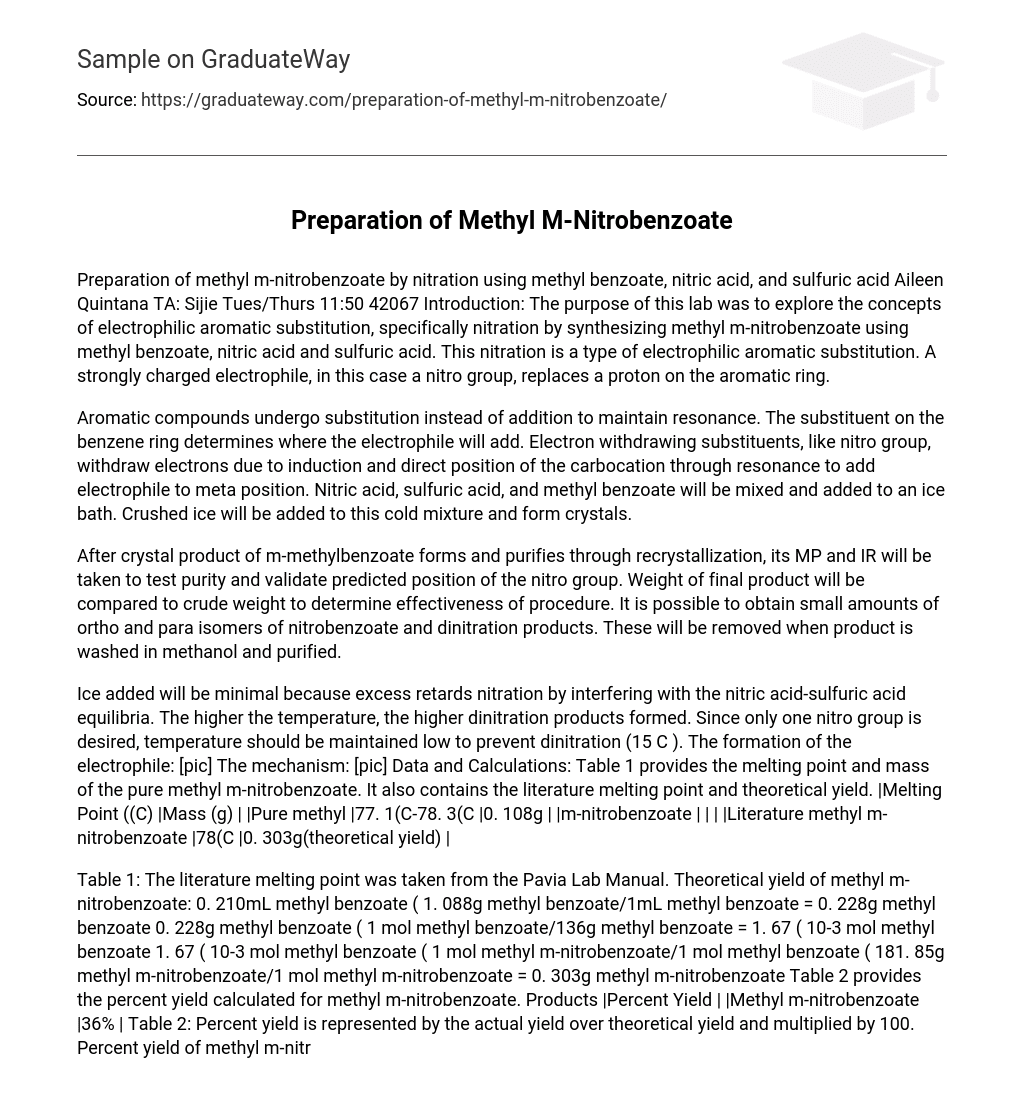Preparation of methyl m-nitrobenzoate by nitration using methyl benzoate, nitric acid, and sulfuric acid Aileen Quintana TA: Sijie Tues/Thurs 11:50 42067 Introduction: The purpose of this lab was to explore the concepts of electrophilic aromatic substitution, specifically nitration by synthesizing methyl m-nitrobenzoate using methyl benzoate, nitric acid and sulfuric acid. This nitration is a type of electrophilic aromatic substitution. A strongly charged electrophile, in this case a nitro group, replaces a proton on the aromatic ring.
Aromatic compounds undergo substitution instead of addition to maintain resonance. The substituent on the benzene ring determines where the electrophile will add. Electron withdrawing substituents, like nitro group, withdraw electrons due to induction and direct position of the carbocation through resonance to add electrophile to meta position. Nitric acid, sulfuric acid, and methyl benzoate will be mixed and added to an ice bath. Crushed ice will be added to this cold mixture and form crystals.
After crystal product of m-methylbenzoate forms and purifies through recrystallization, its MP and IR will be taken to test purity and validate predicted position of the nitro group. Weight of final product will be compared to crude weight to determine effectiveness of procedure. It is possible to obtain small amounts of ortho and para isomers of nitrobenzoate and dinitration products. These will be removed when product is washed in methanol and purified.
Ice added will be minimal because excess retards nitration by interfering with the nitric acid-sulfuric acid equilibria. The higher the temperature, the higher dinitration products formed. Since only one nitro group is desired, temperature should be maintained low to prevent dinitration (15 C ). The formation of the electrophile: [pic] The mechanism: [pic] Data and Calculations: Table 1 provides the melting point and mass of the pure methyl m-nitrobenzoate. It also contains the literature melting point and theoretical yield. |Melting Point ((C) |Mass (g) | |Pure methyl |77. 1(C-78. 3(C |0. 108g | |m-nitrobenzoate | | | |Literature methyl m-nitrobenzoate |78(C |0. 303g(theoretical yield) |
Table 1: The literature melting point was taken from the Pavia Lab Manual. Theoretical yield of methyl m-nitrobenzoate: 0. 210mL methyl benzoate ( 1. 088g methyl benzoate/1mL methyl benzoate = 0. 228g methyl benzoate 0. 228g methyl benzoate ( 1 mol methyl benzoate/136g methyl benzoate = 1. 67 ( 10-3 mol methyl benzoate 1. 67 ( 10-3 mol methyl benzoate ( 1 mol methyl m-nitrobenzoate/1 mol methyl benzoate ( 181. 85g methyl m-nitrobenzoate/1 mol methyl m-nitrobenzoate = 0. 303g methyl m-nitrobenzoate Table 2 provides the percent yield calculated for methyl m-nitrobenzoate. Products |Percent Yield | |Methyl m-nitrobenzoate |36% | Table 2: Percent yield is represented by the actual yield over theoretical yield and multiplied by 100. Percent yield of methyl m-nitrobenzoate: 0. 108g methyl m-nitrobenzoate/0. 303g methyl m-nitrobenzoate = 0. 356g methyl m-nitrobenzoate ( 100 = 36% Discussion and Conclusion:
The nitration of methyl benzoate to prepare methyl m-nitrobenzoate was successful. The melting point of the product was 77. 1(C-78. 3(C. In comparison to the literature’s melting point, 78(C, the melting point obtained in lab is within MP range and resulted a very pure product. The percent yield of the recrystallized methyl m-nitrobenzoate was 36%. The low percent yield was a chemical error. The group added concentrated sulfuric and nitric acid too slowly in the beginning of the 15min period and a fast addition in the end of the 15min period.
Thus, the formation of byproduct increased immediately and reduced the amount of product aquired during the end of the experiment. An infrared spectrum of the product was obtained and confirmed it is methyl m-nitrobenzoate. The spectra showed a peak at 1525. 86cm-1 indicating a –NO2 nitro group. A benzene ring peak at 1615. 61cm-1, a strong C=O carbonyl peak at 1715. 92cm-1, a C-H sp3 at 2960. 92cm-1, and a C-H sp2 at 3092. 41cm-1. These peaks confirmed nitrobenzoate product and the melting point obtained proved it was in the meta position. All data proved that product is indeed methyl m-nitrobenzoate.
This experiment was helpful to understand how electron-withdrawing groups on a benzene ring direct to the meta position and how to create an electrophile in lab. Questions: 1. Why is methyl m-nitrobenzoate formed in this reaction instead of the ortho or para isomers? The starting product, methyl benzoate contains an ester group that is an electron-withdrawing group. This causes the NO2, the deactivating group, to be in the meta position instead of the ortho or para positions. 2. Why does the amount of the dinitration increase at high temperatures?
There is a set activation energy needed to substitute the NO2 group onto the aromatic ring. Adding a second NO2 group, since it is a deactivator, will require higher activation energy than the addition of the first. Higher temperatures will provide more heat energy for activation. Therefore performing this reaction at higher temperatures gives a greater chance of yielding a dinitro compound. 5. Indicate the product formed on nitration of each of the following compounds: benzene, toluene, chlorobenzene, and benzoic acid. Benzene: [pic] Toluene: [pic] Chlorobenzene: [pic] Benzoic Acid: [pic]





